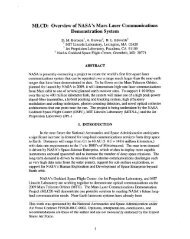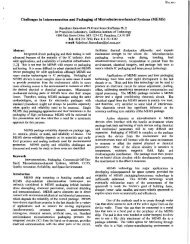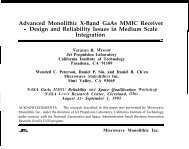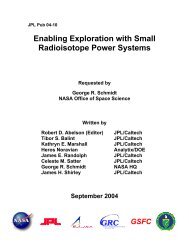Operations Concept for a Solar System Internetwork
Operations Concept for a Solar System Internetwork
Operations Concept for a Solar System Internetwork
You also want an ePaper? Increase the reach of your titles
YUMPU automatically turns print PDFs into web optimized ePapers that Google loves.
SISG<br />
IOAG Space <strong>Internetwork</strong>ing<br />
Strategy Group<br />
CNES DLR ESA JAXA NASA<br />
<strong>Operations</strong> <strong>Concept</strong> <strong>for</strong> a<br />
<strong>Solar</strong> <strong>System</strong> <strong>Internetwork</strong><br />
Charles D. Edwards<br />
Jet Propulsion Laboratory, Cali<strong>for</strong>nia Institute of Technology<br />
Michel Denis<br />
European Space <strong>Operations</strong> Centre<br />
Lena Braatz<br />
Booz Allen Hamilton<br />
Version 1.0<br />
1
SISG<br />
Introduction<br />
�The Interagency <strong>Operations</strong> Advisory Group (IOAG)<br />
has established a Space <strong>Internetwork</strong>ing Strategy<br />
Group (SISG)<br />
� The SISG was chartered to provide recommendations<br />
to the IOAG <strong>for</strong> a strategy to implement space<br />
internetworking<br />
� One element of this work involves the development<br />
and documentation of an operations concept <strong>for</strong> a<br />
solar system internetwork (SSI)<br />
�In 2009-2010, the SISG worked to establish this SSI<br />
operations concept, leading to the release of<br />
“<strong>Operations</strong> <strong>Concept</strong> <strong>for</strong> a <strong>Solar</strong> <strong>System</strong> <strong>Internetwork</strong><br />
(SSI)” in Oct 2011<br />
March 16, 2010 Version 1.0<br />
2
SISG<br />
�Co-chairs:<br />
� Wolfgang Hell – ESA ESOC<br />
� John Rush – NASA HQ<br />
�Members:<br />
� Francois Allard – ESA ESTEC<br />
� Erik Barkley – NASA JPL<br />
� Lena Braatz** - NASA/Booz Allen<br />
Hamilton<br />
� Fred Brosi – NASA/GST<br />
� Scott Burleigh – NASA JPL<br />
� Gian Paolo Calzolari – ESA ESOC<br />
� Vint Cerf - NASA/Google<br />
� Matthew Cosby – UK Space<br />
Agency/QinetiQ<br />
� Michel Denis* - ESA ESOC<br />
� Robert Durst – NASA/MITRE<br />
� Chad Edwards* - NASA JPL<br />
� Roy Gladden – NASA JPL<br />
� Adrian Hooke – NASA HQ<br />
� Dave Israel – NASA GSFC<br />
� Narita Kaneaki - JAXA<br />
* Co-author ** Editor<br />
SISG Membership<br />
March 16, 2010 Version 1.0<br />
Participation from ESA, NASA,<br />
ASI, CNES, DLR, JAXA, et al.<br />
� Greg Kazz – NASA JPL<br />
� Mike Kearney – NASA MSFC<br />
� Paolo Maldari – ESA ESOC (ret)<br />
� Jane Marquart – NASA GSFC<br />
� Gilles Moury - CNES<br />
� John Pietras – NASA/GST<br />
� Martin Pilgram - DLR<br />
� Luca Salotti - ASI<br />
� James Schier – NASA HQ<br />
� Michael Schmidt – ESA ESOC<br />
� Klaus-Juergen Schulz – ESA ESOC<br />
� Keith Scott – NASA/Mitre<br />
� Peter Shames – NASA JPL<br />
� Jason Soloff – NASA JSC<br />
� Wallace Tai – NASA JPL<br />
� Chris Taylor - ESA ESTEC<br />
� Takahiro Yamada - JAXA<br />
3
SISG<br />
The Need <strong>for</strong> an SSI<br />
�To date, most space communications scenarios have<br />
involved simple point-to-point links<br />
� Supported via standardized CCSDS link layer<br />
protocols (e.g., TM/TC, AOS)<br />
�Future space exploration scenarios will move beyond<br />
this simple point-to-point paradigm:<br />
� More complex topologies involving multiple spacecraft<br />
� Data flowing over multiple hops via intermediate relay<br />
spacecraft<br />
� Data flowing to multiple destinations, with data-driven<br />
routing<br />
March 16, 2010 Version 1.0<br />
4
SISG<br />
The Need <strong>for</strong> an SSI (cont’d)<br />
�The SSI drives the need <strong>for</strong> a functional network<br />
layer<br />
� Like terrestrial Internet, provides a simple,<br />
standardized network interface<br />
� A pair of applications at disjoint nodes would be able<br />
to seamlessly exchange data, with the network layer<br />
handling the intermediate routing<br />
User<br />
App<br />
SI<br />
Landed<br />
Spacecraft<br />
SI SI SI SI SI SI SI SI SI<br />
SI: Space <strong>Internetwork</strong>ing Protocol<br />
March 16, 2010 Version 1.0<br />
Earth<br />
Statio<br />
n<br />
Space <strong>Internetwork</strong> Terrestrial <strong>Internetwork</strong><br />
Application data transfer<br />
User<br />
App<br />
Landed<br />
Spacecraft<br />
MOC<br />
5
SISG<br />
�Service User<br />
nodes<br />
� Reside at periphery<br />
of SSI<br />
� Can access SSI<br />
service, but cannot<br />
provide network<br />
layer <strong>for</strong>warding<br />
capability<br />
�Service Provider<br />
nodes<br />
� Can provide network<br />
layer <strong>for</strong>warding<br />
capability<br />
General Description of the SSI<br />
Planetary<br />
WAN<br />
Planet<br />
Spacecraft<br />
Landed<br />
Spacecraft<br />
Planetary<br />
Station<br />
March 16, 2010 Version 1.0<br />
Relay<br />
Spacecraft<br />
Spacecraft<br />
Earth<br />
Station<br />
SSI Node w/ <strong>for</strong>warding capability<br />
(“Service Provider” or “Service User”)<br />
SSI Node w/out <strong>for</strong>warding capability<br />
(“Service User” only)<br />
Spacecraft<br />
Landed S/C<br />
Landed MOCs S/C<br />
MOC<br />
MOC<br />
Earth Station<br />
Control Center<br />
Earth<br />
Science Ops<br />
Center<br />
Terrestrial<br />
WAN<br />
Planetary Station<br />
Control Center<br />
6
Key SSI Principles: Management<br />
SISG<br />
� Asset Responsibility: Each agency is responsible <strong>for</strong> the planning,<br />
control, and operations of its own assets<br />
� Communications Protocols: The operations concept shall, as far<br />
as possible, be independent of the communications protocols below<br />
the network layer<br />
� Addressing: Asset addressing must be constructed and managed<br />
at the network level; the SSI will require an entity to manage and<br />
maintain a repository of addresses.<br />
� Network Services: The defining characteristic of the SSI end state<br />
operations concept is the presence of a functional network layer in<br />
the protocol stack; application layer functionality is only present at<br />
the endpoints of an end-to-end service<br />
� Interoperability: To provide a functional network layer in the<br />
protocol stack, all nodes that agree to provide SSI services will offer<br />
an agreed set of interoperable IP and/or DTN protocol services<br />
March 16, 2010 Version 1.0<br />
7
Key SSI Principles: Planning<br />
SISG<br />
� Network Planning and Management: The SSI requires network<br />
planning and management functions to develop the network contact<br />
plan and execute network services<br />
� Overall Planning: The planning entities of the provider and user<br />
agencies must coordinate at long-term (typically geometry or flight<br />
dynamics), medium-term (typically resources or mission planning),<br />
and short-term (typically service request and delivery) levels<br />
� Contact Plan: Network planning and execution in the SSI end state<br />
hinge on a network contact plan, which establishes the temporal<br />
windows and communications capabilities (e.g., bandwidth) of<br />
individual node-to-node network links<br />
� Peering Agreements: Peering agreements will be used to<br />
implement interagency interfaces within the SSI. When planning<br />
mission communications, an individual user will arrange <strong>for</strong> service<br />
with its agency-level provider, who will, in turn, employ peering<br />
agreements to arrange end-to-end data flows that use different<br />
agencies’ provider nodes.<br />
March 16, 2010 Version 1.0<br />
8
Key SSI Principles: Execution<br />
SISG<br />
� Monitoring/Reporting: The SSI providers shall provide the user<br />
MOC with feedback on the progress and success of the intermediate<br />
steps in the relaying process.<br />
� Transparency: Each node agreeing to participate in the network<br />
shall be indifferent and transparent to any contents of the transferred<br />
data units<br />
� Integrity: The SSI shall be capable of delivering complete, gap-free<br />
data products between any two nodes<br />
� User Emergency: The SSI shall allow <strong>for</strong> defining and using, under<br />
pre-agreed conditions, a path from the user MOC to the user node<br />
that is completely deterministic in geometry and timing (e.g., to<br />
recover from anomalies in the network and/or the user node)<br />
� Routing Functions: The SSI end state operations concept supports<br />
data flow over multiple possible network data paths<br />
� Forwarding of in<strong>for</strong>mation is based on static or dynamic routing<br />
tables in the network-layer protocol with <strong>for</strong>warding decisions based<br />
on in<strong>for</strong>mation in the network-layer Protocol Data Units (as opposed<br />
to being driven by metadata or manually sequenced operations)<br />
March 16, 2010 Version 1.0<br />
9
SISG<br />
�The SSI is a<br />
confederation of<br />
network elements from<br />
multiple international<br />
space agencies<br />
� Each agency serves<br />
as an “SSI Service<br />
Provider” <strong>for</strong> its user<br />
nodes (Iike a<br />
terrestrial ISP)<br />
� “Peering<br />
agreements” are<br />
used to access<br />
services from other<br />
providers<br />
Overview of SSI Coordination<br />
mission<br />
lifecycle<br />
comm rqts<br />
March 16, 2010 Version 1.0<br />
User<br />
User Nodes<br />
User Nodess<br />
Nodes<br />
Agency<br />
B<br />
Agency<br />
A<br />
Develop/maintain mutuallysupportive<br />
cross-support<br />
service & peering agreements<br />
SSI<br />
Coordination<br />
Function<br />
Provider Provider Provider<br />
Nodes Nodes Nodes<br />
Agency<br />
C<br />
Capabilities/<br />
provisioning rqts<br />
10
SISG<br />
SSI Contact Planning Process<br />
�A key element of SSI<br />
operations involves the<br />
development and<br />
distribution of a<br />
contact plan<br />
� Describes the temporal<br />
connectivity and<br />
bandwidth capabilities of<br />
the network<br />
� Is essential to enable<br />
routing and <strong>for</strong>warding<br />
decisions by individual SSI<br />
nodes in support of endto-end<br />
network data<br />
delivery<br />
March 16, 2010 Version 1.0<br />
�Space link per<strong>for</strong>mance extraction<br />
�Network data volume and latency<br />
calculations, reports<br />
Network<br />
Utilization,<br />
Monitoring,<br />
Reporting<br />
Mutual Contact<br />
Determination<br />
Contact Plan<br />
Release +<br />
Verification (of<br />
Release)<br />
�Trajectory predictions<br />
�Communications geometry<br />
�Spacecraft constraints<br />
Contact Plan<br />
Generation<br />
11
SISG<br />
User S/C MOC<br />
User MOC<br />
Mission<br />
Planning<br />
Flight Sys<br />
Analysis<br />
Contact<br />
Opportunities,<br />
Requests &<br />
Constraints<br />
User MOC<br />
SSI Contact Planning Process<br />
Navigation Mission<br />
Planning<br />
Science<br />
Planning<br />
Contact<br />
Plan<br />
Provider S/C MOC<br />
User MOC<br />
Flight Sys<br />
Analysis<br />
Contact<br />
Opportunities,<br />
Requests &<br />
Constraints<br />
User MOC<br />
Confederated Contact Planning Process<br />
March 16, 2010 Version 1.0<br />
Navigation<br />
Science<br />
Planning<br />
(<strong>for</strong> Hybrid<br />
Asset)<br />
Contact<br />
Plan<br />
Earth Station<br />
Control<br />
User MOC<br />
User Center MOC<br />
Earth<br />
Station<br />
Network<br />
Scheduling<br />
Contact<br />
Opportunities,<br />
Requests &<br />
Constraints<br />
Earth<br />
Station<br />
N/W Asset<br />
Monitoring<br />
Contact<br />
Plan<br />
12
SISG<br />
User MOC<br />
Application Layer<br />
Network Layer<br />
Link Layer<br />
SSI Run-Time <strong>Operations</strong><br />
SSI Network<br />
Service<br />
Link Layer<br />
Service<br />
Intermediate<br />
Provider<br />
Node(s)<br />
End-to-End SSI Service<br />
Network Layer<br />
Link Layer<br />
Network Monitoring<br />
March 16, 2010 Version 1.0<br />
SSI Network<br />
Service<br />
Link Layer<br />
Service<br />
User S/C<br />
Application Layer<br />
Network Layer<br />
Link Layer<br />
13
SISG<br />
Conclusions<br />
� The IOAG’s Space <strong>Internetwork</strong>ing Strategy Group has<br />
established an operations concept <strong>for</strong> a solar system<br />
internetwork<br />
� Provides robust and efficient end-to-end data services spanning<br />
terrestrial and space links up to interplanetary scales<br />
� Utilizes a standard network layer (IP or DTN)<br />
� Incorporates many aspects of the terrestrial Internet, while<br />
reflecting the unique challenges of space communications<br />
� A key aspect of the SSI operations concept involves the<br />
development and dissemination of the contact plan describing<br />
the temporal connectivity of SSI nodes and the bandwidth<br />
characteristics of individual links<br />
� Once this contact plan has been established, network<br />
communication can proceed in a highly automated fashion, with<br />
intermediate nodes using knowledge of the contact plan to drive<br />
<strong>for</strong>warding and routing decisions<br />
March 16, 2010 Version 1.0<br />
14
SISG<br />
BACKUP<br />
March 16, 2010<br />
Version 1.0<br />
15
SISG<br />
Acknowledgments<br />
�The authors thank all the members of the Space<br />
<strong>Internetwork</strong>ing Strategy Group <strong>for</strong> their many<br />
valuable inputs in reviewing and refining this SSI<br />
operations concept<br />
�Part of the research described in this paper was<br />
carried out at the Jet Propulsion Laboratory, Cali<strong>for</strong>nia<br />
Institute of Technology, under a contract with the<br />
National Aeronautics and Space Administration<br />
Version 1.0<br />
16


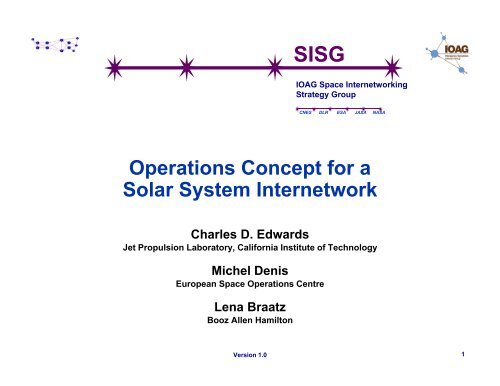
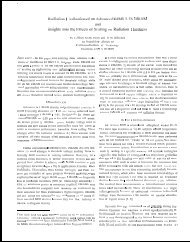


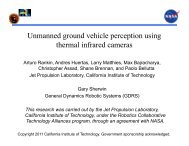
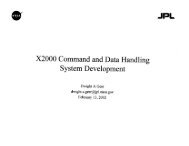


![Ana]ysis of Reaction Products and Conversion Time in the Pyrolysis ...](https://img.yumpu.com/11715548/1/190x242/anaysis-of-reaction-products-and-conversion-time-in-the-pyrolysis-.jpg?quality=85)
